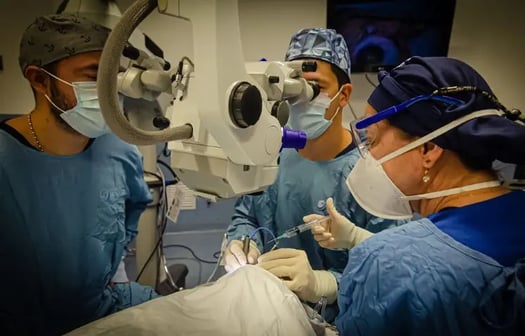
Refractive diseases or also known as refractive defects, are those that occur due to a deficiency in the normal functioning of the eye that is unable to provide visual acuity. In general terms, they are presented by an irregularity in the shape of the eye or cornea or by the rigidity of the crystalline lens after the age of 40 or 45, generating a reduction in the focusing capacity of the eye. Some refractive errors can present from childhood and others appear over the years.
According to the Abecé document for the Early Detection of Refractive Defects of the Ministry of Health and Social Protection, the main symptoms of refractive diseases are blurred vision, itching, a feeling of tension in the eyes and, occasionally, headache. Eye strain and migraines are the result of the permanent effort that the eyes make to try to "focus" correctly. These symptoms usually disappear when the defect is corrected, either with glasses, contact lenses or by surgery. These types of eye diseases can also present with double vision, hazy sensations, glare, or halos around bright lights in the eyes.
Although pain in the eye is rare, refractive errors are very annoying, disabling, and affect the quality of life of anyone who suffers from them. Fortunately, they are also relatively easy to treat and at the Sandiego Ophthalmology Clinic in Medellín, thousands of patients have successfully resolved refractive errors that they presented at some point in their lives.
Early detection and diagnosis of refractive diseases
Enjoying good visual health requires periodic eye examination to rule out refractive diseases. This examination is recommended every one or two years by visual health specialists. Additionally, in the presence of any of the aforementioned symptoms, it is important that the patient consult the professionals at the Sandiego Ophthalmology Clinic as soon as possible. There a specialist will carry out the diagnostic process, which will be
known as an eye exam and measures visual acuity. For children, eye screening is recommended to detect any type of eye problem before it interferes with learning.
In the ocular examination, it is the one that is carried out with a table (with numbers and letters) that helps to determine the sharpness or acuity of vision. Although refractive diseases can occur in eyes without an ophthalmologic history, diagnostic tests also include assessments such as testing visual fields, eye pressure, and eye movement.
Tailor-made treatments to correct refractive errors
According to the Minsalud report, the correction of refractive defects or diseases is possible through the use of glasses, contact lenses or, in some cases, through refractive surgeries. “The correction criterion of moderate and high degrees begins with the prescription of non-invasive methods as an excellent corrective option, as long as there is tolerance of the prescription. When there are high degrees of refractive errors, surgical management is suggested, especially if there is rejection of contact lenses, or glasses due to their excessive thickness or weight, in this case refractive surgery is the corrective method of first choice", he states. The report.
The surgical procedure varies according to the diagnosis made by the ophthalmologist. The intervention is aimed at adjusting the eye's ability to focus by shaping the cornea. According to the American Academy of Ophthalmology (AAO), the most commonly performed type of refractive surgery is the LASIK (Laser-Assisted in Situ Keratomileusis) procedure, which uses a laser to reshape the cornea. Other refractive surgery interventions reduce the curvature of the cornea to improve the focus of the eye and correct myopia. “Farsightedness can be corrected with refractive surgery that steepens the cornea to increase the eye's focusing power. Astigmatism can be corrected with refractive surgery techniques that selectively reshape portions of an irregular cornea to make it smooth and symmetrical. The result is that images are clearly focused on the retina instead of being distorted by light scattering caused by an irregularly shaped cornea,” explains a study published on the subject by the AA.
Refractive diseases are a very common vision problem but one that entails enormous difficulties for those who suffer from them on a daily basis. The visual health specialists at the Sandiego Ophthalmology Clinic have the knowledge, experience, technology, and quality that is required to care for any of these diseases. Leave the health of your eyes in the hands of our experts.
Sandiego Ophthalmology Clinic, experts in eye health
In summary, under normal conditions the cornea and the crystalline lens carry out the effect of refraction of the light rays that penetrate the eye to focus them on the retina. When there is a defect in this process, the cornea and the crystalline lens cannot correctly focus the light rays on the retina and blurred or unfocused vision occurs, the clearest symptoms of the presence of refractive diseases. Go to our ophthalmologists in Medellín, visual health specialists to make sure you do not have any vision problems or rule out any refractive defect.
If you have any questions or present any symptoms, schedule your appointment with one of our specialists now.

 Pay your appointment
Pay your appointment




